1 Introduction
Designing consumer electronics that include both Wi-Fi and Bluetooth will encounter many problems, especially if simultaneous mode of operation is required. Bluetooth and 802.11b/g WLAN systems operate in the 2.4 GHz band, both of which use an important part of the available spectrum (see Figure 1).
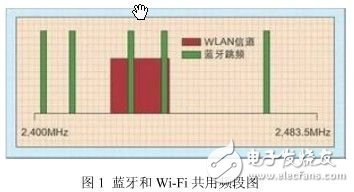
Interference occurs when a WLAN device and a Bluetooth device are in close proximity and attempt to simultaneously transmit and receive wireless signals. These two techniques use different methods for signal transmission: carrier sense multiple access (CSMA) and frequency hopping spread spectrum. The former is used in 802.11b/g transceivers, which listen to idle channels before sending signals. The transmitted signal has a bandwidth of approximately 20 MHz and will occupy one of up to three non-overlapping channels with a spacing of 25 MHz.
Bluetooth uses frequency hopping spread spectrum technology to skip frequency selection at a rate of 1,600 hops per second between 79 channels of 1 MHz bandwidth, and transmits shorter time division multiplexed data packets at each hopping point. When a device initiates a connection and becomes the master of the subnet, the Bluetooth connection is successfully established. If the target address is known, the device sends a page message directly. If the target address is unknown, a query message will be sent first, followed by a resend page message. Once the two devices are synchronized, the two Bluetooth-enabled devices are connected and each device has a unique MAC address. It can be confirmed by simple calculation that the signal output by the Bluetooth transmitter and the 802.11b/g signal will collide in about 25% of the time.
This common channel interference effect and the relative strength of the signal are closely related to the transmission length and duty cycle of the data packet. Various analyses and simulation tests conducted on this interference phenomenon have shown that interference can seriously affect one or both of the signals. The relevant standards provide different signal design methods—direct sequence spread spectrum (DSSS) used by 802.11b, orthogonal frequency division multiplexing (OFDM) used by 802.11g, and interference bounce caused by frequency hopping using Bluetooth. These standards also use protocols based on packet retransmission and data rate reduction. However, these countermeasures can greatly reduce data throughput, which can seriously affect the performance of some devices. For example, Bluetooth audio transmission or VoIP over WLAN, packet error rate of more than a few percent will lead to unbearable audio delay or even call interruption. Two methods for coexisting interference, AFH (Adaptive Frequency Hopping) and AFH combined with three-wire coexistence (time division multiplexing), are proposed below.
2 AFH (Adaptive Frequency Hopping) Technology Introduction and Test Results
The AFH technology is an improvement on the original Bluetooth hopping sequence, which allows the Bluetooth device to reduce the number of hopping points. The basic principle is to distinguish the good and deteriorated channels in the ISM band, thereby avoiding the use of degraded channels and reducing the number of channels. The degree of interference. When the Bluetooth piconet enters the AFH state, the number of hopping points N that can be used by its hopping sequence is dynamically changed, and its maximum value does not exceed 79. AFH is only used for connection status, and does not change the hopping sequence when paging, querying, etc.
The implementation of the adaptive frequency hopping selection mechanism is based on the frequency selection core of the original 79 hop system (the Bluetooth 1.2 protocol stipulates that the 23 hop system is no longer used), and the AFH_mode and AFH_channel_map parameters are added.
AFH_mode indicates whether the current frequency selective core can use the adaptive frequency hopping sequence; AFH_channel_map indicates which channels are available and which channels are unavailable. First, the original frequency-selective core generates a channel. If the channel is an available channel defined in the AFH_channel_map, no adjustment is made directly as an output of the hopping sequence; if the channel is included in the unavailable channel, the relocation function will be used. It is mapped into an available channel. This mapping relationship is one-to-one, that is, if a Bluetooth address, clock, and AFH_channel_map are given, an unavailable RF channel will be uniquely converted into an available channel, thus ensuring the use of AFH in the same piconet. The master-slave device of the mechanism is able to keep the hopping sequence synchronized.
Under this implementation mechanism, the hopping sequence of the non-adaptive 79-hop system is equal to the frequency sequence generated by the available AFH frequency-selective core, which makes it easy to maintain compatibility with the original non-AFH device. .
Another change of the AFH technology is that in the original frequency hopping system, the master and slave nodes respectively transmit data using different frequencies; when in the AFH state, during a master-slave session, the slave node uses the same RF channel as the master node to the master. The node responds to the data packet, which is called the same channel mechanism of the AFH. The use of the same channel mechanism is mainly due to the fact that in the case of interference in the network, reducing the frequency hopping can prevent the slave node from jumping to the channel that may collide when transmitting the response packet, ensuring that the data is not easily received during at least one master-slave conversation. Interference, to achieve the purpose of increasing throughput.
Unfortunately, technologies such as AFH are specifically designed for 2.4 GHz devices to detect and avoid interference, and are not sufficient for Bluetooth to coexist with WLAN. When Bluetooth and 802.11 devices coexist in the same design, AFH as an independent technology is not enough. This is mainly because WLAN devices must provide high output power to support long distance, high data rate, reliable Internet, voice, Data and video transmission. Figure 2 shows a simulation of the phone using both Bluetooth and Wi-Fi. At this time, Wi-Fi is transmitting data, and the Bluetooth headset is receiving a call from PHS.
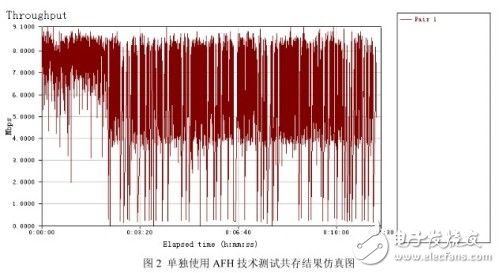
Using AFH technology alone, the Wi-Fi throughput is reduced by about 20%, and the PHS receives a lot of noise. It can be seen that the WIFI transmission of the mobile phone interferes with the reception of the mobile phone Bluetooth.
3 AFH technology combined with three-wire coexistence (time division multiplexing) technology to solve interference problems
AFH technology has been introduced above. The use of AFH technology alone to use Bluetooth headsets is not very good. In order to solve this problem, three-line coexistence (time division multiplexing) technology is used on the basis of AFH technology. The three-line coexistence, as the name suggests, is to use three wires to connect Wi-Fi and Bluetooth. The three-wire coexistence mechanism is described below in conjunction with the three-wire connection diagram shown in Wi-Fi and Bluetooth in Figure 3. The main processor uses TI's OMAP1621 chip.
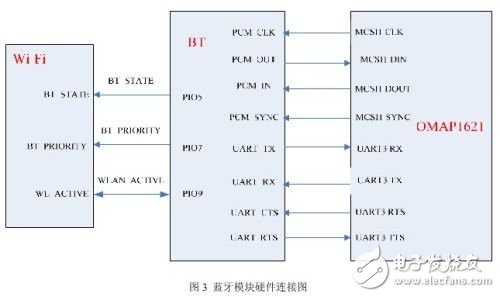
As can be seen from Figure 3, the three-wire connection consists of three signal lines: RF_ACTIVE, BT_STATE, and WLAN_ACTIVE. RF_ACTIVE is a signal line sent from the Bluetooth device to the Wi-Fi device, which notifies the Wi-Fi device that the Bluetooth device is working at this time, and RF_ACTIVE is valid during the transmission and reception of the entire Bluetooth. Due to hardware needs, it must be connected to PIO7 and cannot be changed.
BT_STATE is also a signal line sent by the Bluetooth device to the Wi-Fi device, which informs the Wi-Fi device whether the Bluetooth is in the transmitting state or the receiving state at this time. This signal line must be connected to the Bluetooth PIO5 pin due to hardware requirements.
WLAN_ACTIVE is a signal line sent by a Wi-Fi device to Bluetooth, which is used to notify the Bluetooth Wi-Fi device that data is to be transmitted or received, and the operation of the next Bluetooth should be cancelled. This signal line is connected to PIO9 by default.
This type of three-wire connection is generally only available on BlueCore4 and higher Bluetooth cores.
The three-line coexistence here essentially uses time-division coexistence technology, and the next Bluetooth task action will be cancelled when the Wi-Fi device is about to send or receive data. Bluetooth tasks are generally divided into high priority and low priority. When high priority tasks work, if Wi-Fi is working at this time, the Wi-Fi task will be canceled when Bluetooth is executed. For low priority tasks, if Wi-Fi is also working, then the Bluetooth task should be cancelled.
The use of AFH and three-wire coexistence technology can solve the problem of voice quality of Bluetooth headset calls, and the effect of Wi-Fi transmission data is better. Figure 4 is a simulation of Bluetooth and Wi-Fi testing with both technologies in use.
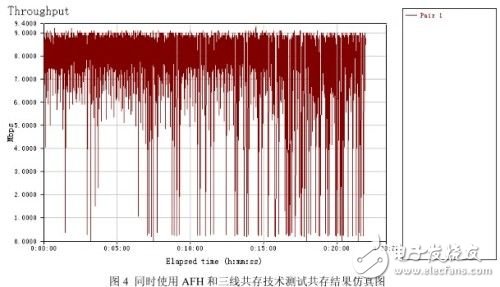
4 Conclusion
This paper introduces the combination of AFH technology and AFH technology and three-wire coexistence technology to solve the problem of Bluetooth and Wi-Fi coexistence on smart phones. The results of the two solutions are obtained through the test results. AFH technology and three-wire coexistence technology can be used. Better solve the problem of coexistence between Bluetooth and Wi-Fi. I believe that this solution will be more and more used in other terminals that have both wireless devices in the future.
TWS Earphone
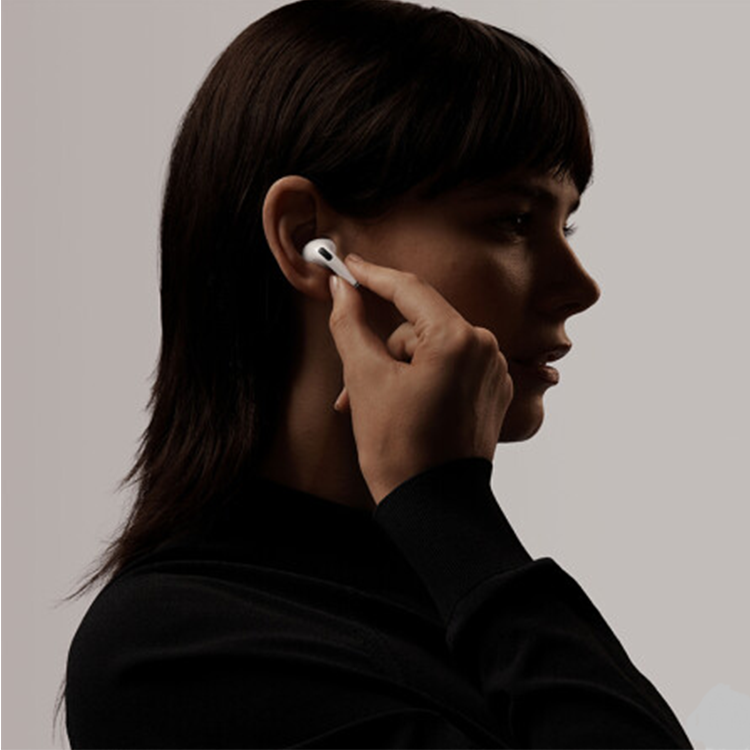
TWS Earphone,Baseus Wireless Earphones,Tws Under 1000,Lenovo Ear Buds
Pogo Technology International Ltd , https://www.wisesir.net
